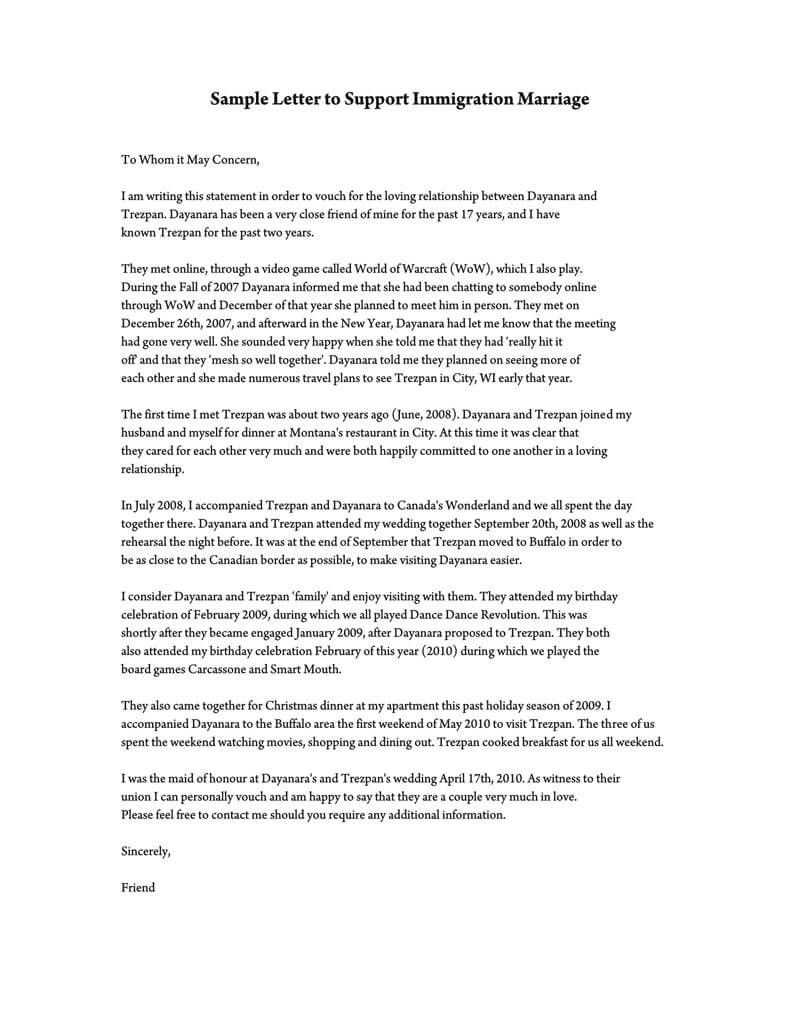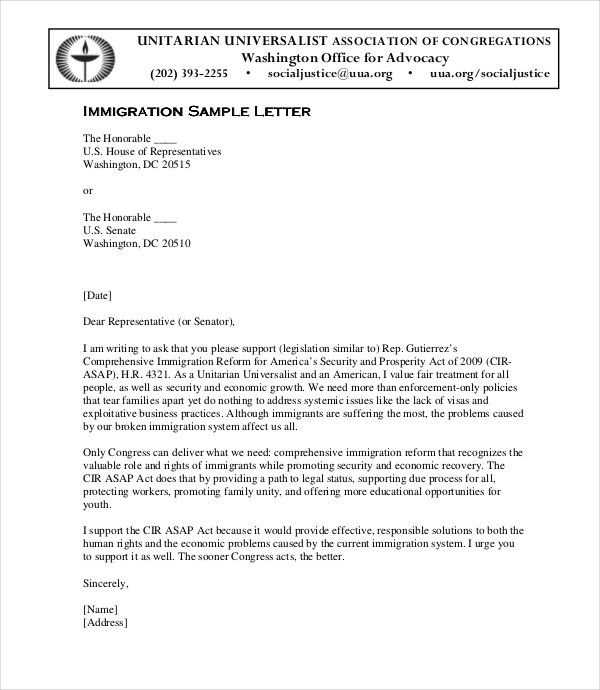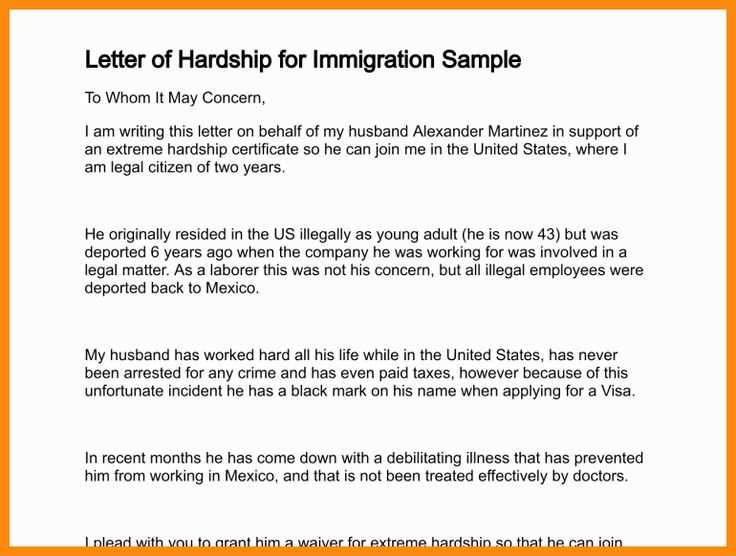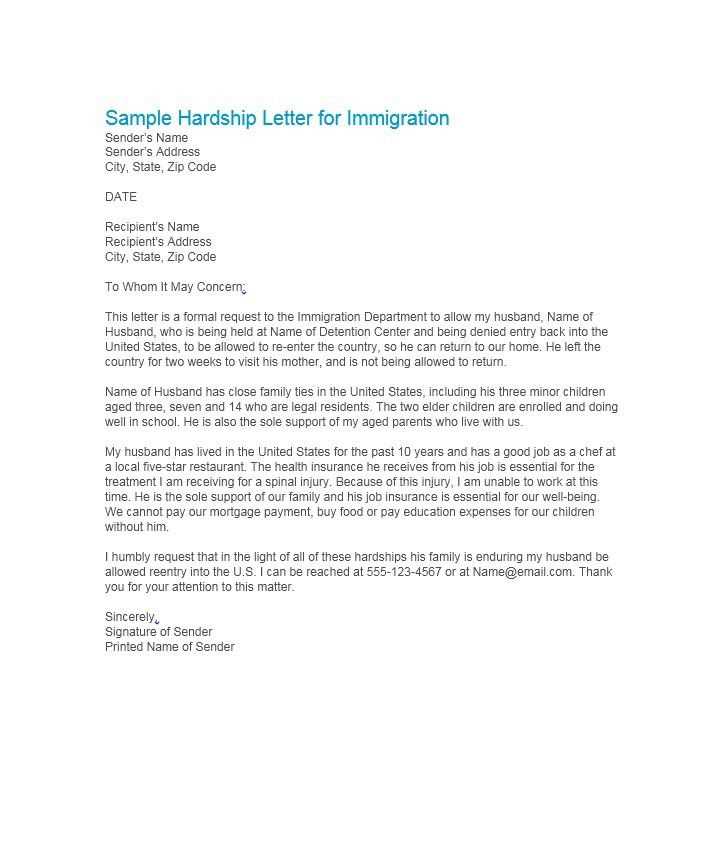Letter of Support Template for Immigration

When applying for a visa or other official status, providing a written endorsement from a trusted individual can significantly strengthen your case. These documents play a crucial role in proving your character, intentions, and relationships with those involved in the process. Crafting an impactful endorsement requires understanding the key elements that make it persuasive and effective.
In this guide, we will explore how to structure such a document, ensuring it meets all the necessary criteria while maintaining a professional and personal tone. Whether you are the one writing it or the recipient of such an endorsement, knowing the essential aspects of this correspondence can greatly enhance its credibility and influence.
Understanding the purpose behind these communications is vital, as they are not just formalities, but a way to demonstrate the strength of your application. This article provides practical insights into how to craft one that resonates with the reviewing authorities.
The Role of Support Letters in Immigration
In official applications related to residency or travel, written endorsements serve as a critical tool to validate the claims and qualifications of the applicant. These documents help establish the applicant’s credibility, intentions, and the nature of their relationships with others involved in the process. By providing a personal and professional perspective, these letters strengthen the overall application, offering additional proof to decision-makers.
Enhancing Credibility and Trust
When an individual seeks approval from an immigration authority, demonstrating their reliability and trustworthiness can be essential. An endorsement from a credible source adds weight to the applicant’s narrative, helping officials better understand the character and intentions of the person seeking entry. This can be particularly valuable when the application lacks direct evidence or when the applicant is applying under complex circumstances.
Demonstrating Connections and Support
Another important aspect of these documents is their ability to illustrate the applicant’s connections to individuals or communities. Whether through personal or professional ties, showing the support of friends, family, or employers can highlight the applicant’s integration into society and their likelihood of following through with their commitments. Such endorsements often serve to underline the stability and support network the individual has in place.
Key Elements to Include in Your Letter
When writing an endorsement document, it’s essential to ensure that certain components are clearly articulated to make the communication as effective as possible. Including the right details helps build trust and provides the necessary information that decision-makers need to evaluate the application. Below are the critical elements that should be present to create a well-rounded and compelling letter.
Introduction and Personal Connection
The opening of the document should establish the relationship between the writer and the applicant. It’s important to mention how long the writer has known the person and the nature of their connection. This provides context and credibility to the endorsement. A strong introduction sets the tone and assures the reader of the reliability of the following statements.
Clear Purpose and Specific Support

In the body of the letter, it’s crucial to clearly outline the purpose of the endorsement and the specific areas in which the applicant is being supported. Whether it’s the applicant’s character, their professional abilities, or their ties to a community, these details should be explicitly mentioned. Being specific about how the writer is able to vouch for the applicant strengthens the document and makes it more relevant to the immigration process.
Conclusion should reinforce the positive attributes of the applicant, briefly summarizing why they are a good candidate for the opportunity being applied for. A strong closing leaves a lasting impression and reassures the reader of the applicant’s merits.
How to Write a Convincing Document
To create a persuasive endorsement, it’s important to craft a message that is both clear and compelling. The document should provide a strong case for the applicant, highlighting their qualities and the reasons they deserve consideration. By following a structured approach, you can ensure that the message resonates with decision-makers and supports the applicant’s case effectively.
Structuring Your Message
Begin with a clear introduction that outlines the purpose of the document. Then, focus on the applicant’s qualifications, attributes, and the reasons they are a strong candidate. Provide specific examples whenever possible to support your claims. A well-organized message is much more impactful and easy for the reader to follow.
Choosing the Right Tone
The tone of the document should be respectful, professional, and sincere. While it’s important to be enthusiastic, make sure not to overstate claims or sound too emotional. A balanced tone ensures the document comes across as credible and authoritative.
| Key Element | What to Include |
|---|---|
| Introduction | Clearly state the purpose of the document and relationship with the applicant. |
| Main Body | Provide specific examples of the applicant’s strengths and abilities. |
| Conclusion | Reaffirm the applicant’s qualifications and express confidence in their abilities. |
Common Errors to Avoid in Letters
When crafting a document meant to endorse an individual, it’s crucial to avoid common mistakes that could weaken the message or undermine the document’s effectiveness. These errors can detract from the purpose of the endorsement and potentially harm the applicant’s chances. Understanding and steering clear of these issues ensures that the message remains strong, clear, and persuasive.
One frequent mistake is failing to provide specific examples to support claims. General statements, while well-meaning, do not carry the same weight as tangible examples that demonstrate the applicant’s qualities. Additionally, overly emotional or exaggerated language can come across as less credible. It’s important to maintain a professional tone and avoid sounding insincere or biased.
Another pitfall is neglecting to structure the document properly. A disorganized message may confuse the reader and detract from the key points. Keeping the content clear and concise, with a logical flow, makes the endorsement more effective. Lastly, spelling and grammatical errors can significantly damage the document’s professionalism and reduce its credibility.
Different Formats for Immigration Letters
There are various ways to present an endorsement document, depending on the purpose and the relationship between the writer and the applicant. The format chosen can significantly impact how the document is perceived and its effectiveness in supporting the applicant’s case. Understanding the different structures and when to use them ensures that the message is tailored to the specific needs of the situation.
One common format is the formal recommendation, where the writer provides a detailed and structured account of the applicant’s qualifications and character. This type is often used by employers, professors, or other authoritative figures who can vouch for the applicant’s skills or contributions. Another format might be a more personal and informal account, typically written by close friends or family members, emphasizing the applicant’s personal qualities and the strength of the relationship.
There are also specialized formats, such as character references, which focus more on the applicant’s integrity and moral standing. These are often required in situations where trust and character play a pivotal role. Each format should be chosen based on the intended purpose of the document, ensuring it best represents the applicant’s strengths and suitability for the opportunity they are seeking.
Customizing Your Support Letter Effectively
Tailoring your endorsement document to suit the specific needs of the recipient can significantly enhance its impact. Customization allows you to highlight the most relevant details and present the applicant’s strengths in the context of the situation they are facing. By adjusting the tone, content, and structure to reflect the unique circumstances, you ensure the document resonates with its intended audience.
Focus on Relevant Information

Each document should be customized to emphasize the qualities and experiences that are most pertinent to the applicant’s goal. Here are a few key areas to focus on:
- Personal relationship: Highlight the duration and nature of your relationship with the applicant.
- Applicant’s achievements: Focus on accomplishments that directly relate to the purpose of the application.
- Specific skills: Mention any particular skills that make the applicant stand out in the context of their objective.
Adjust the Tone and Structure

The tone of the document should be adjusted based on the nature of the request. For a formal situation, the language should remain professional, clear, and concise. In contrast, when writing a more personal endorsement, the tone can be slightly warmer and more personal, focusing on the applicant’s character. Consider the following when adjusting the structure:
- Ensure a logical flow of ideas from introduction to conclusion.
- Provide detailed examples to support each point.
- Maintain a respectful and positive tone throughout the document.